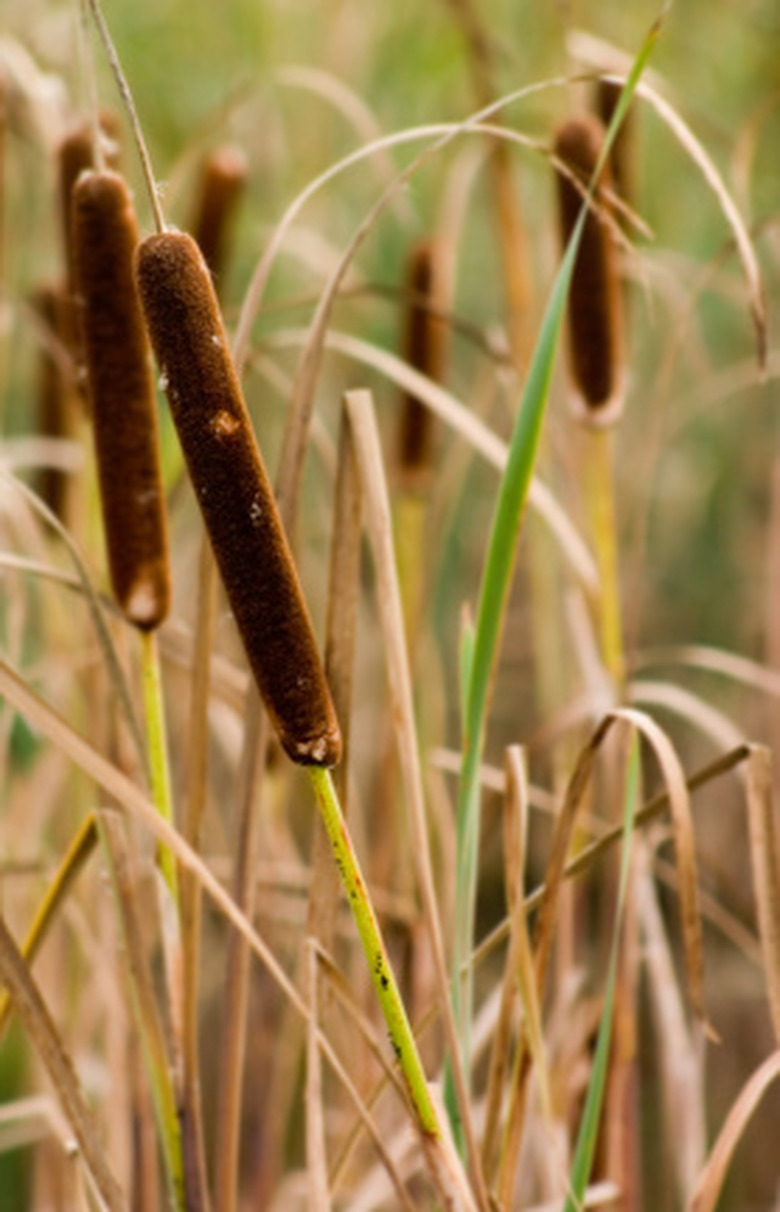Plants Found In Lakes & Ponds
Some of the plants in lakes and ponds are beneficial, and others are considered invasive. Birds, amphibians, reptiles and mammals make nests and feed on aquatic plants. Barrow's Goldeneye Duck is just one species of waterfowl that nests in the vegetation growing in shallow water on the shores of lakes and ponds. On the other hand, plants around ponds and lakes such as purple loosestrife change entire water ecosystems with their invasive nature.
Bulrush Provides Nesting Areas
Bulrush Provides Nesting Areas
Bulrush grows in shallow water, and it is the nest of choice of different birds, reptiles, insects, amphibians and fish. Water birds also feed on the plant's seeds, and muskrats eat its stems and roots. This plant has a hard stem that tapers at the top. Close to the tapered end, short branches sprout and hold clusters of gray to brown flowers that look fleecy. Bulrush often grows along the edges of ponds or wetlands, and it spreads by rhizomes in standing water or wet soils.
Muskrats Build Homes Among Cattails
Muskrats Build Homes Among Cattails
The cattail's name comes from the spongy brown section of the plant's long stem, which to some resembles a cat's tail. It has creeping roots that propagate quickly in shallow water, and its stems are so hard that muskrats use them to build their homes. Groups of this swamp, lake and pond vegetation also serve as a nesting area for Red-winged Blackbirds and Yellow-headed Blackbirds, as well as others.
Filamentous Algae, aka "Pond Scum"
Filamentous Algae, aka "Pond Scum"
If you've ever seen a green layer of vegetation covering a large portion of a pond or lake, you were probably looking at filamentous algae, sometimes called "pond scum." This algae, as the name suggests, is composed of millions of filaments without leaves, roots or stems that float on the surface of slow-moving water.
The state of Missouri considers it a nuisance aquatic plant because where it exists, no one can fish or swim. Filamentous algae also has the potential to block sunlight and render water intake screens useless.
Watershield Leaves Float
Watershield Leaves Float
The watershield plant is native to the state of Florida. Its oval, shield-shaped leaves float on the surface of the water, while its leaf stalks extend both above and below the water. The leaf stalks grow to depths of six feet and attach to the plant's roots buried in mud on the bottoms of lakes and ponds. The watershield also produces a small purple flower that stands above water on a stem.
Invasive Purple Loosestrife
Invasive Purple Loosestrife
Purple loosestrife arrived in North America from Europe in the 19th century in the luggage of immigrants who valued its purple flowers. It has since become an invasive aquatic plant, taking over any waterway where it creates roots. Other plants usually can't compete with purple loosestrife and are eliminated from the ecosystem, which leads to the disappearance of animals dependent on them for nutrition. Purple loosestrife has a four-sided stem, close to which small purple flowers bloom on the top end. The plant's leaves appear on the stem under the flower cluster.
Giant Water Lily
Giant Water Lily
With round lily pads up to eight feet across, the giant water lily grows best in still, quiet water, like the edges of small ponds or the backwaters of rivers. The flowers are white when they first open and have a fragrant, pineapple-like scent. Giant water lilies will bloom for a day or two more, but the blossoms will become more pink and will lose their scent after the first day. The stalks of this aquatic plant can be up to 26 feet long, with roots anchored to the bottom of the river, lake or pond it is growing in.
Cite This Article
MLA
Watkins, Emma. "Plants Found In Lakes & Ponds" sciencing.com, https://www.sciencing.com/plants-found-in-lakes-ponds-12337319/. 30 September 2021.
APA
Watkins, Emma. (2021, September 30). Plants Found In Lakes & Ponds. sciencing.com. Retrieved from https://www.sciencing.com/plants-found-in-lakes-ponds-12337319/
Chicago
Watkins, Emma. Plants Found In Lakes & Ponds last modified August 30, 2022. https://www.sciencing.com/plants-found-in-lakes-ponds-12337319/
